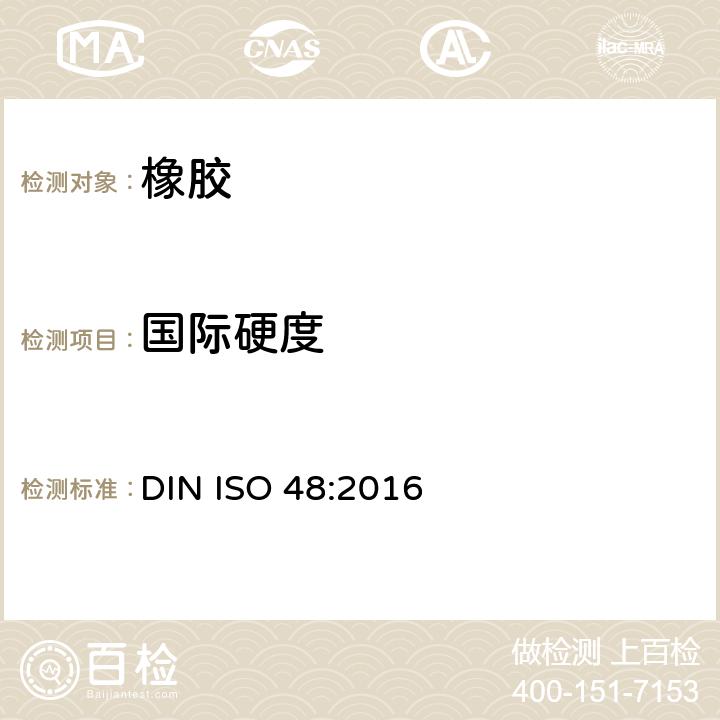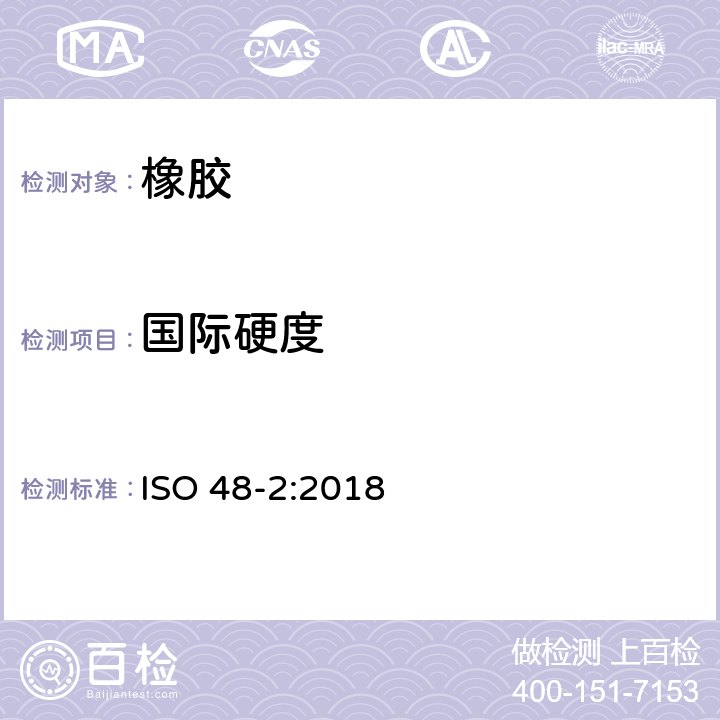DIN ISO 48-2009 硫化或热塑橡胶.硬度的测定(硬度在10 IRHD至100 IRHD之间)(ISO 48:2007),DIN ISO 48:2009-10的英文版本
百检网 2021-07-15
标准号:DIN ISO 48-2009
中文标准名称:硫化或热塑橡胶.硬度的测定(硬度在10 IRHD至100 IRHD之间)(ISO 48:2007),DIN ISO 48:2009-10的英文版本
英文标准名称:Rubber, vulcanized or thermoplastic - Determination of hardness (hardness between 10 IRHD and 100 IRHD) (ISO 48:2007);English version of DIN ISO 48:2009-10
标准类型:G35
发布日期:1999/12/31 12:00:00
实施日期:1999/12/31 12:00:00
中国标准分类号:G35
国际标准分类号:83.060
引用标准:ISO 18898;ISO 23529
适用范围:1.1 GeneralThis International Standard specifies four methods for the determination of the hardness of vulcanized orthermoplastic rubbers on flat surfaces (standard-hardness methods) and four methods for the determination ofthe apparent hardness of curved surfaces (apparent-hardness methods). The hardness is expressed ininternational rubber hardness degrees (IRHD). The methods cover the hardness range from 10 IRHD to100 IRHD.The methods differ primarily in the diameter of the indenting ball and the magnitude of the indenting force,these being chosen to suit the particular application. The range of applicability of each method is indicated inFigure 1.The determination of hardness by a pocket hardness meter is described in ISO 7619-2.1.2 Standard-hardness methodsMethod N: Normal test -- This method is appropriate for rubbers with a hardness in the range 35 IRHD to85 IRHD, but may also be used for hardnesses in the range 30 IRHD to 95 IRHD.Method H: High-hardness test -- This method is appropriate for rubbers with a hardness in the range 85 IRHDto 100 IRHD.Method L: Low-hardness test -- This method is appropriate for rubbers with a hardness in the range 10 IRHDto 35 IRHD.Method M: Microtest -- This method is essentially a scaled-down version of the normal test method N,permitting the testing of thinner and smaller test pieces. It is appropriate for rubbers with a hardness in therange 35 IRHD to 85 IRHD, but may also be used for hardnesses in the range 30 IRHD to 95 IRHDNOTE 1 The value of the hardness obtained by method N within the ranges from 85 IRHD to 95 IRHD and from30 IRHD to 35 IRHD may not agree precisely with that obtained using method H or method L, respectively. The differenceis not normally significant for technical purposes.NOTE 2 Because of various surface effects in the rubber and the possibility of slight surface roughness (produced, for example, by buffing), the microtest may not always give results agreeing with those obtained by the normal test.1.3 Apparent-hardness methodsAlso specified are four methods. CN CH. CL and CM, for the determination of the apparent hardness ofcurved surfaces. These methods are modifications of methods N, H, L and M. respectively, for cases wherethe rubber surface tested is curved. Two cases exist, depending whethera) the test piece or product tested is large enough for the hardness instrument to rest upon it;b) it is small enough for both the test piece and the instrument to rest upon a common support.A variant of b) would be where the test piece rests on the specimen table of the instrumentApparent hardness can also be measured an non-standard flat test pieces usJng methods N, H, L and M.The procedures described cannot provide for all possible shapes and dimensions of test piece, but coversome of the commonest types, such as O-ringsDetermination of the apparent hardness of rubber-covered rollers is dealt with separately in the various partsof ISO 7267
中文标准名称:硫化或热塑橡胶.硬度的测定(硬度在10 IRHD至100 IRHD之间)(ISO 48:2007),DIN ISO 48:2009-10的英文版本
英文标准名称:Rubber, vulcanized or thermoplastic - Determination of hardness (hardness between 10 IRHD and 100 IRHD) (ISO 48:2007);English version of DIN ISO 48:2009-10
标准类型:G35
发布日期:1999/12/31 12:00:00
实施日期:1999/12/31 12:00:00
中国标准分类号:G35
国际标准分类号:83.060
引用标准:ISO 18898;ISO 23529
适用范围:1.1 GeneralThis International Standard specifies four methods for the determination of the hardness of vulcanized orthermoplastic rubbers on flat surfaces (standard-hardness methods) and four methods for the determination ofthe apparent hardness of curved surfaces (apparent-hardness methods). The hardness is expressed ininternational rubber hardness degrees (IRHD). The methods cover the hardness range from 10 IRHD to100 IRHD.The methods differ primarily in the diameter of the indenting ball and the magnitude of the indenting force,these being chosen to suit the particular application. The range of applicability of each method is indicated inFigure 1.The determination of hardness by a pocket hardness meter is described in ISO 7619-2.1.2 Standard-hardness methodsMethod N: Normal test -- This method is appropriate for rubbers with a hardness in the range 35 IRHD to85 IRHD, but may also be used for hardnesses in the range 30 IRHD to 95 IRHD.Method H: High-hardness test -- This method is appropriate for rubbers with a hardness in the range 85 IRHDto 100 IRHD.Method L: Low-hardness test -- This method is appropriate for rubbers with a hardness in the range 10 IRHDto 35 IRHD.Method M: Microtest -- This method is essentially a scaled-down version of the normal test method N,permitting the testing of thinner and smaller test pieces. It is appropriate for rubbers with a hardness in therange 35 IRHD to 85 IRHD, but may also be used for hardnesses in the range 30 IRHD to 95 IRHDNOTE 1 The value of the hardness obtained by method N within the ranges from 85 IRHD to 95 IRHD and from30 IRHD to 35 IRHD may not agree precisely with that obtained using method H or method L, respectively. The differenceis not normally significant for technical purposes.NOTE 2 Because of various surface effects in the rubber and the possibility of slight surface roughness (produced, for example, by buffing), the microtest may not always give results agreeing with those obtained by the normal test.1.3 Apparent-hardness methodsAlso specified are four methods. CN CH. CL and CM, for the determination of the apparent hardness ofcurved surfaces. These methods are modifications of methods N, H, L and M. respectively, for cases wherethe rubber surface tested is curved. Two cases exist, depending whethera) the test piece or product tested is large enough for the hardness instrument to rest upon it;b) it is small enough for both the test piece and the instrument to rest upon a common support.A variant of b) would be where the test piece rests on the specimen table of the instrumentApparent hardness can also be measured an non-standard flat test pieces usJng methods N, H, L and M.The procedures described cannot provide for all possible shapes and dimensions of test piece, but coversome of the commonest types, such as O-ringsDetermination of the apparent hardness of rubber-covered rollers is dealt with separately in the various partsof ISO 7267
百检能给您带来哪些改变?
1、检测行业全覆盖,满足不同的检测;
2、实验室全覆盖,就近分配本地化检测;
3、工程师一对一服务,让检测更精准;
4、免费初检,初检不收取检测费用;
5、自助下单 快递免费上门取样;
6、周期短,费用低,服务周到;
7、拥有CMA、CNAS、CAL等权威资质;
8、检测报告权威有效、中国通用;
客户案例展示
相关商品
版权与免责声明
①本网注名来源于“互联网”的所有作品,版权归原作者或者来源机构所有,如果有涉及作品内容、版权等问题,请在作品发表之日起一个月内与本网联系,联系邮箱service@baijiantest.com,否则视为默认百检网有权进行转载。
②本网注名来源于“百检网”的所有作品,版权归百检网所有,未经本网授权不得转载、摘编或利用其它方式使用。想要转载本网作品,请联系:service@baijiantest.com。已获本网授权的作品,应在授权范围内使用,并注明"来源:百检网"。违者本网将追究相关法律责任。
③本网所载作品仅代表作者独立观点,不代表百检立场,用户需作出独立判断,如有异议或投诉,请联系service@baijiantest.com
相关问答




















